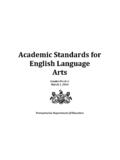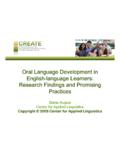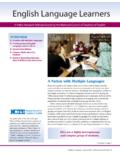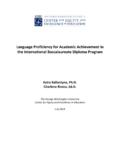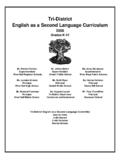Transcription of Strategies for Teaching Mathematics to English …
1 Strategies for Teaching Mathematics to English language Learners Presented by Beatrice Moore-Harris Numbers Mathematics Professional Development International Math Conference July 7-9, 2005. San Antonio, Texas About the presenter: Beatrice Moore-Harris is an outstanding teacher and an excellent presenter. She has devoted her 25-year career in Mathematics education to working with struggling students, especially in the area of Mathematics . In demand as a speaker at state and national conferences, she has provided teachers across the country with practical Strategies for Teaching struggling students. She is a former member of the Board of Directors for the National Council of Teachers of Mathematics , member of the TEKS 6-8 writing team, and is the co-author of Algebra I, Algebra II, and Mathematics Applications and Connections Courses 1, 2.
2 And 3. "I hope that this professional development experience will provide you with practical Strategies , ideas and tools you can use immediately. Our focus will be on providing the appropriate Mathematics content, Strategies , activities and methods that accelerate the learning of English language Learners (ELL). students. I have used these methods with my students, and they really work!". Table of Contents I. II. Second language Acquisition III. Challenges for Teachers and Students ..11. IV. Cultural Differences In the Related to Mathematics 15. V. Strategies for Teaching Mathematics to ELL VI. LEP Resources ..22. VII. Mathematics VIII. References .24. I. Goals One of the performance goals of the No Child Left Behind Act of 2001.
3 (NCLB) requires ELL students to become proficient in English while reaching high academic achievement standards in reading/ language arts and Mathematics . NCLB also requires that ELL students participate in annual academic assessments in reading/ language arts and Mathematics , which are used to determine adequate yearly progress for schools, school divisions, and the state. The goal of this professional development is to provide Mathematics teachers with: a brief overview of second language acquisition theory information about cultural differences effective Strategies for differentiating instruction for English language Learners (ELL). Strategies to align instruction with the TEKS in a manner which supports ELL.
4 Opportunities to network and dialogue with colleagues Agree or Disagree . ELL Students learn English easily and quickly simply by being exposed to and surrounded by native English speakers. When ELLs are able to converse comfortably in English , they have developed proficiency in the language . In earlier times immigrant children learned English rapidly and assimilated easily into American life. II. Second language Acquisition Research Learning a second language is a complex process that develops in predictable, sequential stages. This progression closely mirrors the stages children go through as they learn their first language (Krashen & Terrell, 1983). During the initial period of learning a second language , ELL students may experience a silent period during which they concentrate on comprehension and respond using non-verbal means of communication (Krashen,1985).
5 With increased exposure to the English language , ELL students progress through several additional stages of language acquisition. Following the silent period, ELL students typically begin to produce one- or two-word responses and use short repetitive phrases. At the next stage, ELL students start to produce simple sentences and engage in basic dialogue. Within one to two years, ELL students begin to use more complex statements, can sustain longer conversations, and state their opinions. At the final stage of language acquisition, most ELL students can understand grade- level classroom activities, argue and defend academic points, read grade-level textbooks, and write organized and fluent essays (Krashen, 1982).
6 The chart below summarizes general behaviors of ELL students at each stage of language acquisition (Krashen, 1982). Stage of language Acquisition Behaviors of LEP Students Silent/Receptive Stage Silent/Receptive Stage point to objects, act, nod, or use 10 hours to 6 months gestures 500 receptive words say yes or no peak hesitantly Early Production Stage produce one- or two-word phrases 6 months to 1 year use short repetitive language 1000 receptive/active words focus on key words and context clues Speech Emergence Stage engage in basic dialogue 1-2 years respond using simple sentences 3000 active words Intermediate Fluency Stage use complex statements 2-3 years state opinions and original thoughts 6000 active words ask questions interact in more lengthy conversations Advanced Fluency Stage converse fluently 5-7 years understand grade- level classroom content area vocabulary activities argue and defend
7 academic points read grade- level textbooks write organized and fluent essays The five stages of language acquisition described above are a general framework for understanding how ELL students progress; however, language learning is an ongoing, fluid process that differs for every student. Students may move back and forth between stages depending on the academic demands of a lesson and the amount of participation required. For example, a ELL student may be functioning at the intermediate fluency stage when performing routine tasks or accessing previously learned skills. However, when the academic content is new and the student lacks adequate background knowledge or experiences, the student may regress to the prior stage (early production).
8 For language acquisition to occur, students must (1) receive understandable and meaningful messages that are a little beyond their comprehension level and (2) learn in an environment where there is little or no anxiety (Krashen, 1981, 1982; Vygotsky, 1978). Recognizing these two principles can assist teachers in creating a natural language learning environment in their classrooms. Outlined below are five key elements of an effective language learning environment. Use of these Strategies can assist all students in accessing the content material. 1) Comprehensible input Teachers can make their language more comprehensible by modifying their speech, adjusting Teaching materials, and adding context to lessons.
9 2) Reduced anxiety level A student's emotions play a pivotal role in assisting or interfering with learning a second language . Teachers can assist students by creating a comfortable classroom environment that encourages participation and risk-taking without fear of feeling embarrassed or foolish. (Krashen, 1981; Krashen & Terrell, 1983). 3) Contextual clues Visual support makes language more comprehensible. For example, a lesson about fractions using manipulatives is more understandable than an explanation of the concept. Even social language is more comprehensible when context is added. For example, understanding a face-to-face conversation using facial expressions and gestures is easier than a telephone conversation (Cummins, 1981).
10 4) Verbal interaction Students need opportunities to work together to solve problems and use English for real, meaningful purposes. They need to give and receive information and complete authentic tasks. 5) Active participation - Lessons that encourage active involvement motivate LEP. students, engage them in the learning process, and help them remember content more easily. Types of language Proficiency Another theory about language acquisition that can help teachers understand the challenges of ELL students is the distinction between social and academic language proficiency. Jim Cummins (1981) suggests that there are two types of language proficiency: 1) Basic interpersonal communication skills (BICS).

